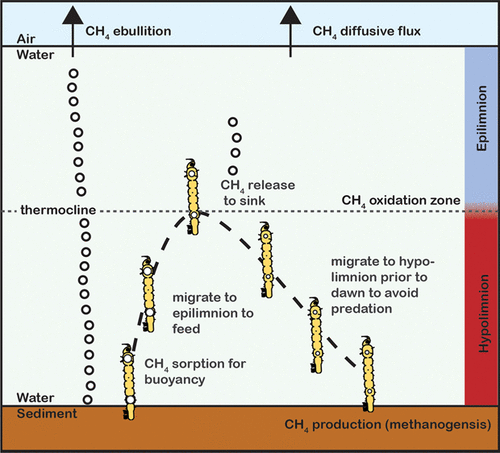当前位置:
X-MOL 学术
›
Environ. Sci. Technol.
›
论文详情
Our official English website, www.x-mol.net, welcomes your feedback! (Note: you will need to create a separate account there.)
Chaoborus spp. Transport CH4 from the Sediments to the Surface Waters of a Eutrophic Reservoir, But Their Contribution to Water Column CH4 Concentrations and Diffusive Efflux Is Minor
Environmental Science & Technology ( IF 11.4 ) Pub Date : 2018-01-12 00:00:00 , DOI: 10.1021/acs.est.7b04384 Cayelan C. Carey 1 , Ryan P. McClure 1 , Jonathan P. Doubek 1 , Mary E. Lofton 1 , Nicole K. Ward 1 , Durelle T. Scott 2
Environmental Science & Technology ( IF 11.4 ) Pub Date : 2018-01-12 00:00:00 , DOI: 10.1021/acs.est.7b04384 Cayelan C. Carey 1 , Ryan P. McClure 1 , Jonathan P. Doubek 1 , Mary E. Lofton 1 , Nicole K. Ward 1 , Durelle T. Scott 2
Affiliation

|
Chaoborus spp. (midge larvae) live in the anoxic sediments and hypolimnia of freshwater lakes and reservoirs during the day and migrate to the surface waters at night to feed on plankton. It has recently been proposed that Chaoborus take up methane (CH4) from the sediments in their tracheal gas sacs, use this acquired buoyancy to ascend into the surface waters, and then release the CH4, thereby serving as a CH4 “pump” to the atmosphere. We tested this hypothesis using diel surveys and seasonal monitoring, as well as incubations of Chaoborus to measure CH4 transport in their gas sacs at different depths and times in a eutrophic reservoir. We found that Chaoborus transported CH4 from the hypolimnion to the lower epilimnion at dusk, but the overall rate of CH4 transport was minor, and incubations revealed substantial variability in CH4 transport over space and time. We calculated that Chaoborus transport ∼0.1 mmol CH4 m–2 yr–1 to the epilimnion in our study reservoir, a very low proportion (<1%) of total CH4 diffusive flux during the summer stratified period. Our data further indicate that CH4 transport by Chaoborus is sensitive to water column mixing, Chaoborus density, and Chaoborus species identity.
中文翻译:

潮虫属 将CH 4从沉积物输送到富营养化水库的地表水,但它们对水柱CH 4浓度和扩散流出的贡献较小。
潮虫属 mid(幼虫)白天生活在缺氧沉积物和淡水湖泊和水库的低渗中,晚上迁移到地表水以浮游生物为食。最近有人提出,潮虫从气管气囊中的沉积物中吸收甲烷(CH 4),利用这种获得的浮力上升到地表水中,然后释放CH 4,从而成为CH 4的“泵”。大气。我们使用diel调查和季节性监测,以及用Chaoborus的孵化来测量富营养化储层中不同深度和时间的气囊中CH 4的运输,从而检验了这一假设。我们发现潮汕在黄昏时将CH 4从下层向下上层运输,但CH 4的总体运输速率很小,并且温育表明CH 4的运输随时间和空间变化很大。我们计算出,潮汐藻将〜0.1 mmol CH 4 m –2 yr –1运至我们研究储层中的上扬层,在夏季分层期中占总CH 4扩散通量的比例非常低(<1%)。我们的数据进一步表明,潮虫的CH 4转运对水柱混合,潮虫密度和水汽浓度敏感。潮汕物种身份。
更新日期:2018-01-12
中文翻译:

潮虫属 将CH 4从沉积物输送到富营养化水库的地表水,但它们对水柱CH 4浓度和扩散流出的贡献较小。
潮虫属 mid(幼虫)白天生活在缺氧沉积物和淡水湖泊和水库的低渗中,晚上迁移到地表水以浮游生物为食。最近有人提出,潮虫从气管气囊中的沉积物中吸收甲烷(CH 4),利用这种获得的浮力上升到地表水中,然后释放CH 4,从而成为CH 4的“泵”。大气。我们使用diel调查和季节性监测,以及用Chaoborus的孵化来测量富营养化储层中不同深度和时间的气囊中CH 4的运输,从而检验了这一假设。我们发现潮汕在黄昏时将CH 4从下层向下上层运输,但CH 4的总体运输速率很小,并且温育表明CH 4的运输随时间和空间变化很大。我们计算出,潮汐藻将〜0.1 mmol CH 4 m –2 yr –1运至我们研究储层中的上扬层,在夏季分层期中占总CH 4扩散通量的比例非常低(<1%)。我们的数据进一步表明,潮虫的CH 4转运对水柱混合,潮虫密度和水汽浓度敏感。潮汕物种身份。



























 京公网安备 11010802027423号
京公网安备 11010802027423号